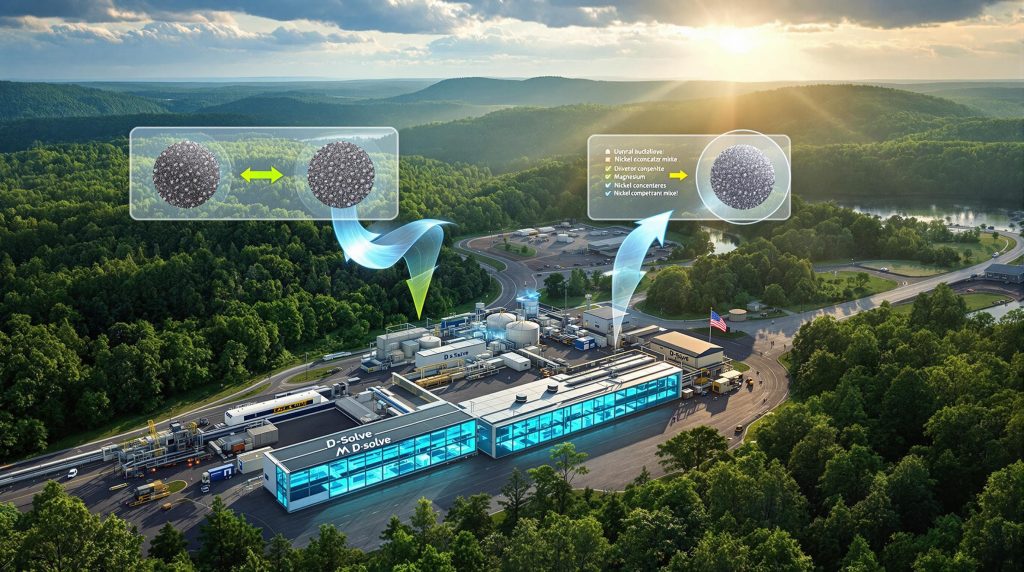Eagle Mine: Pioneering the Future of Nickel Production with D-Solve Technology
Eagle Mine, nestled in Michigan's Upper Peninsula, stands as the only active nickel producer in the United States. Since commencing operations in 2014, this underground mining facility has played a crucial role in strengthening North America's critical minerals supply chain while providing valuable employment opportunities to the region.
What makes Eagle Mine particularly noteworthy in 2025 is its groundbreaking partnership with Allonnia to pilot an innovative Eagle Mine and Allonnia nickel purification technology called D-Solve. This collaboration represents a significant step forward in addressing one of the most persistent challenges in nickel processing: the presence of impurities like magnesium that diminish concentrate value and recovery rates.
The Role of Eagle Mine in U.S. Nickel Production
As the sole active nickel producer in the United States, Eagle Mine occupies a unique position in the North American minerals landscape. Located in Michigan's Upper Peninsula, the underground operation has been extracting nickel and copper since 2014, contributing significantly to domestic critical mineral supplies.
The mine's strategic importance extends beyond mere production figures. In a global context where supply chain resilience has become paramount, Eagle Mine represents a crucial link in North America's ability to secure nickel—an essential component in batteries, stainless steel, and numerous advanced manufacturing applications.
Beyond its national security implications, Eagle Mine has created substantial economic benefits for Michigan's Upper Peninsula, generating employment opportunities and supporting regional development in an area historically dependent on resource extraction industries facing nickel industry challenges.
Why Purification Is a Game Changer for Nickel Processing
The nickel concentration process faces a persistent challenge that has limited recovery rates and economic viability: the presence of impurities, particularly magnesium. These unwanted materials create significant obstacles in the production chain with far-reaching consequences.
Magnesium impurities specifically affect smelter acceptance, often resulting in valuable nickel being discarded in tailings. This not only represents a direct economic loss but also creates additional waste material requiring management and storage.
"Meeting the surging demand for critical minerals requires a fundamental shift in how we extract value from increasingly complex ores," notes Allonnia CEO Nicole Richards, highlighting the industry-wide challenge that Eagle Mine's pilot project aims to address.
The stakes are particularly high given nickel's growing importance in critical minerals & energy transition. As a key component in electric vehicle batteries and renewable energy storage systems, efficient nickel processing directly impacts the green technology supply chain. Improving purification methods therefore represents not just an operational efficiency but a strategic advantage in the clean energy transition.
How Does Allonnia's D-Solve Nickel Purification Technology Work?
The D-Solve technology represents a departure from conventional metal processing approaches, utilizing biological mechanisms rather than traditional chemical methods. This innovative approach promises to transform how nickel concentrates are purified while potentially reducing environmental impacts.
Scheduled for deployment in the fourth quarter of 2025, the D-Solve mobile unit will process between one and two tonnes of concentrate daily at Eagle Mine, operating continuously to demonstrate its capabilities under real production conditions.
What Makes D-Solve Distinct in Metals Processing?
D-Solve stands apart from conventional purification technologies through its biological approach to metal processing. Unlike traditional methods that often rely on energy-intensive physical separation or harsh chemical treatments, D-Solve employs engineered biosolutions to target specific impurities.
The technology functions as a "bolt-on" system, designed for operational flexibility and integration with existing processing infrastructure. This modular approach allows mining operations to implement the technology without major overhauls to their current systems—a significant advantage for established mines looking to improve concentrate quality.
The mobile nature of the D-Solve unit enables rapid deployment at mine sites, making it particularly valuable for operations looking to test or implement the technology without extensive preparation or infrastructure development. This mobility could potentially allow multiple sites to benefit from the technology sequentially, maximizing its industry impact.
Step-by-Step: The Purification Process at Eagle Mine
The D-Solve process at Eagle Mine will follow a systematic approach to nickel purification:
-
Collection of nickel concentrate containing unwanted materials, particularly magnesium, from Eagle Mine's existing processing operations
-
Transfer of this concentrate to the D-Solve mobile unit, where the biological purification process occurs
-
Application of the proprietary biosolutions that specifically target and remove magnesium impurities from the concentrate
-
Continuous processing of 1-2 tonnes of concentrate daily throughout the pilot program
-
Collection of the purified concentrate with reduced magnesium content and higher nickel grade
-
Ongoing monitoring and analysis of the process effectiveness, stability, and potential for scalability
This systematic approach will allow Eagle Mine and Allonnia to gather comprehensive data on D-Solve's performance in a live production environment, creating valuable insights for potential broader implementation.
What Are the Measurable Results from D-Solve's Previous Demonstrations?
Before its implementation at Eagle Mine, D-Solve underwent testing at SGS Lakefield in Ontario in December 2024. These preliminary demonstrations provided compelling evidence of the technology's effectiveness, establishing baseline expectations for the upcoming Eagle Mine pilot.
Key Performance Metrics (as Demonstrated at SGS Lakefield, Ontario)
| Metric | Pre-D-Solve | Post-D-Solve | Improvement |
|---|---|---|---|
| Magnesium (impurity) content | Baseline | -40% | Reduced by 40% |
| Nickel concentration (grade) | Baseline | +18% | Increased by 18% |
| Recovery and biosolution recyclability | Stable | Stable | No decrease |
The SGS Lakefield demonstration delivered impressive results across key performance indicators. Most notably, the technology achieved a 40% reduction in magnesium impurities—the primary target of the purification process. This substantial decrease in unwanted materials translates directly to improved concentrate quality and smelter acceptance.
Equally significant was the 18% increase in nickel grade achieved through the D-Solve process. This enhancement represents a substantial value addition, effectively concentrating more nickel into the same volume of material. For mining operations with grade challenges, this improvement could transform marginally economic resources into valuable assets.
Featured Insight:
The D-Solve trials at SGS Lakefield demonstrated not just impressive impurity reduction and grade improvement, but also showed the biosolutions could be recycled through multiple processing cycles while maintaining stable recovery rates—a critical factor for operational sustainability and cost management.
The Pilot at Eagle Mine: What Will Be Monitored?
The upcoming pilot at Eagle Mine will expand on previous demonstrations by testing the technology in a continuous, real-world production environment. This implementation will focus on several key performance indicators:
- Real-time data on nickel recovery rates under actual production conditions
- Concentrate purity measurements, particularly focusing on magnesium reduction
- Operational reliability of the system during continuous 24/7 operation
- Assessment of the technology's impact on downstream processing
- Evaluation of potential mine life extension through improved resource utilization
- Analysis of scalability potential for broader implementation
As Eagle Mine Managing Director Darby Stacey notes, the technology "could improve our operations today while also paving the way for future operations that could benefit from the knowledge generated at Eagle Mine." This forward-looking perspective highlights the pilot's dual role in delivering immediate operational benefits while building knowledge for future applications.
How Could This Technology Redefine Nickel Mining Sustainability and Economics?
The D-Solve technology offers potential transformative benefits across both environmental and economic dimensions of nickel mining. By improving resource utilization efficiency and reducing waste generation, the technology aligns with the industry's increasing focus on sustainable mining transformation while potentially enhancing operational economics.
Environmental and Economic Benefits for Critical Mineral Supply Chains
D-Solve's approach to nickel purification offers several interconnected environmental and economic advantages:
-
Maximized resource utilization: By improving recovery from existing ore bodies, D-Solve helps mines extract more value from the same resource, potentially extending mine life and reducing the need for new extraction sites.
-
Reduced waste generation: Higher recovery rates translate directly to less nickel being discarded in tailings, decreasing the volume of waste material requiring management and storage.
-
Lower processing intensity: The biological approach may reduce reliance on energy-intensive or chemically harsh traditional purification methods, potentially decreasing the environmental footprint of concentrate processing.
-
Enhanced marketability: By removing smelter-limiting impurities, D-Solve creates higher-value concentrates that may access premium markets or avoid penalties applied to lower-quality materials.
-
Circular processing potential: The demonstrated recyclability of the biosolutions supports a more circular approach to mineral processing, reducing input requirements and waste generation.
These benefits are particularly significant in the context of growing demand for nickel in clean energy applications. As Allonnia CEO Nicole Richards emphasizes, the technology is "engineered to unlock value from low-grade ores, improve concentrate quality and reduce environmental impact"—a trifecta of benefits aligned with both sustainability and economic objectives.
Industry Perspectives: Why Biological Innovation Matters
The mining industry has historically relied on mechanical and chemical approaches to mineral processing, with biological methods remaining relatively unexplored until recently. The emergence of technologies like D-Solve represents a significant shift in thinking about how critical minerals can be processed.
Expert Perspective:
Industry leaders increasingly recognize that bolt-on biosolutions offer a potentially transformative approach to existing challenges, particularly as operations face tightening environmental regulations and the need to process increasingly complex ore bodies with traditional methods becoming less economically viable.
The adoption of biological innovation in mining also aligns with broader trends toward modern mining & ESG. As mines face growing pressure to reduce environmental impacts while maintaining economic viability, technologies that can deliver on both fronts become increasingly valuable.
For established operations like Eagle Mine, these innovations offer the potential to:
- Enhance operational efficiency through improved recovery rates
- Extend productive lifespan by making previously uneconomic resources viable
- Improve concentrate marketability by eliminating smelter-blocking impurities
- Align with global trends for lower-emission, more sustainable mining practices
These potential benefits explain why Eagle Mine has chosen to pioneer D-Solve's implementation, positioning itself at the forefront of an emerging trend in mining innovation trends.
How Does Eagle Mine and Allonnia's Partnership Shape the Future of Mining Innovation?
The collaboration between Eagle Mine and Allonnia represents more than just a technology implementation—it embodies a forward-thinking approach to mining innovation that could establish new standards for the industry. By testing D-Solve in a live production environment, the partners aim to generate valuable data and insights that could benefit mining operations globally.
What's Unique About the 2025 On-Site Pilot?
The Eagle Mine pilot stands apart from previous D-Solve demonstrations in several key ways:
- It represents the first deployment of D-Solve technology in a functioning commercial nickel mine rather than a testing facility
- The system will operate continuously to mirror real-world production demands, testing performance under actual operational conditions
- The pilot will assess performance within an established processing chain, providing insights into integration challenges and opportunities
- The implementation will generate data on long-term reliability and consistency, crucial factors for wider adoption
- The project will examine how biological purification interacts with existing downstream processing steps
"Eagle Mine is excited to be the first nickel producer to pilot D-Solve in a live processing environment," states Managing Director Darby Stacey, highlighting the pioneering nature of the implementation.
This real-world testing environment will provide invaluable insights that laboratory or small-scale demonstrations simply cannot match. By subjecting the technology to the variability and demands of actual production conditions, the pilot will establish a much clearer picture of D-Solve's practical value and limitations.
From Pilot to Industry Standard: The Road Ahead
While the Eagle Mine pilot represents an important milestone, the broader impact of D-Solve technology will depend on its path from this initial implementation to potential industry-wide adoption. Several factors will influence this trajectory:
- Scalability assessment: The pilot will evaluate whether D-Solve can be effectively scaled for wider use beyond the initial 1-2 tonnes per day capacity
- Cross-mineral applications: Success with nickel could open possibilities for applying similar approaches to other metals facing impurity challenges
- Economic modeling: The pilot will help establish more accurate cost-benefit analyses for different operational contexts
- Knowledge transfer: As Darby Stacey notes, the pilot aims to generate knowledge that could benefit "future operations"
- Supply chain implications: Widespread adoption could strengthen critical mineral supply chains by improving recovery from existing resources
Nicole Richards frames the collaboration as "a pivotal step in proving that bolt-on biological innovation can redefine how critical minerals are processed both economically and sustainably." This perspective emphasizes the potential for D-Solve to establish not just a new technology but a new paradigm in mineral processing.
Frequently Asked Questions (FAQ): Eagle Mine and Bioprocessing for Nickel
What is the significance of magnesium removal in nickel concentrates?
Magnesium represents a particularly problematic impurity in nickel concentrates for several reasons:
- It can significantly affect smelter acceptance, potentially limiting market options
- High magnesium content often results in valuable nickel being discarded in tailings
- Smelters may apply penalties or reject concentrates with elevated magnesium levels
- Removing magnesium improves the overall grade and value of the concentrate
The 40% reduction in magnesium achieved in previous D-Solve demonstrations illustrates the technology's potential to address this specific challenge.
How does D-Solve differ from traditional refining technology?
D-Solve represents a fundamentally different approach to impurity removal:
- It utilizes biological mechanisms rather than chemical leaching or roasting
- The system is designed as a modular, bolt-on unit rather than requiring extensive infrastructure
- It specifically targets problematic impurities like magnesium
- The process has demonstrated biosolution recyclability, supporting operational sustainability
- The mobile unit design allows for flexible deployment at existing operations
These distinctions position D-Solve as a complement or alternative to traditional refining approaches, potentially offering advantages in specific operational contexts.
What scale is being tested at Eagle Mine?
The Eagle Mine pilot will test D-Solve at a controlled but operationally relevant scale:
- The mobile unit will process between one and two tonnes of concentrate daily
- The system will operate continuously to mirror actual production conditions
- The pilot will run through real nickel concentrate from Eagle Mine's operations
- The implementation will test integration with existing processing infrastructure
- The scale is designed to generate statistically significant data while managing implementation risks
This scale balances the need for meaningful operational insights with practical constraints of new technology implementation.
What are the implications for U.S. and global supplies of critical minerals?
The successful implementation of D-Solve could have several important implications:
- Improved recovery rates could increase effective domestic nickel production without expanding extraction
- Enhanced ability to process complex ores could expand the viable resource base
- Better utilization of existing resources supports supply chain security objectives
- The technology could potentially be applied to other critical minerals facing similar challenges
- Improved economics for challenging deposits could support domestic production capacity
As the only active nickel producer in the United States, Eagle Mine's successful implementation could have particular significance for domestic critical mineral supply chains.
Comparative Table: Traditional Nickel Purification vs. D-Solve Bioprocessing
| Aspect | Traditional Chemical Purification | Allonnia D-Solve Bioprocessing |
|---|---|---|
| Method | Chemical leaching or roasting | Engineered biosolutions |
| Impurity Removal | Variable (often costly) | High efficacy for magnesium removal (40% reduction demonstrated) |
| Environmental Impact | High (toxic byproducts possible) | Lower (biodegradable solutions) |
| Scalability | Infrastructure-heavy | Mobile, modular, rapidly deployable |
| Recovery Rates | Can be limited by impurity levels | Stable with 18% nickel grade improvement demonstrated |
| Infrastructure Requirements | Typically requires significant fixed infrastructure | Mobile unit deployable at existing operations |
| Processing Flexibility | Often optimized for specific ore characteristics | Adaptable biological approach |
| Implementation Timeline | Typically requires lengthy construction/installation | Rapid deployment possible with mobile unit |
This comparison highlights the distinctive features of D-Solve relative to conventional approaches, particularly its mobility, environmental profile, and demonstrated effectiveness for magnesium removal.
What Could Success Mean for Mining's Future?
The Eagle Mine pilot represents more than just a technology implementation—it potentially signals a shift in how the mining industry approaches resource recovery and processing challenges. Successful demonstration of D-Solve's capabilities in a live production environment could catalyze broader innovation and adoption of biological approaches across the sector.
For the nickel industry specifically, proven success at Eagle Mine could establish a new benchmark for sustainable extraction by demonstrating that improved recovery, reduced impurities, and enhanced environmental performance are achievable simultaneously. This alignment of economic and sustainability objectives could accelerate industry transformation.
Beyond nickel, the principles and approaches demonstrated through D-Solve could potentially transfer to other metal recovery challenges. Copper, cobalt, and other critical minerals often face similar impurity and recovery challenges that might benefit from biological innovation.
The timing of this pilot is particularly significant given the accelerating demand for nickel in clean energy applications, especially electric vehicle batteries. Technologies that can maximize recovery from existing resources while minimizing environmental impacts directly support the broader clean energy transition.
Ultimately, the Eagle Mine and Allonnia nickel purification technology demonstrates how mining—an industry with ancient roots—continues
Looking for an Edge in ASX Mining Investments?
Discover significant mineral opportunities before the broader market with Discovery Alert's proprietary Discovery IQ model, which transforms complex ASX announcements into actionable insights. Explore our dedicated discoveries page to understand how major mineral discoveries have historically generated substantial returns for investors.




